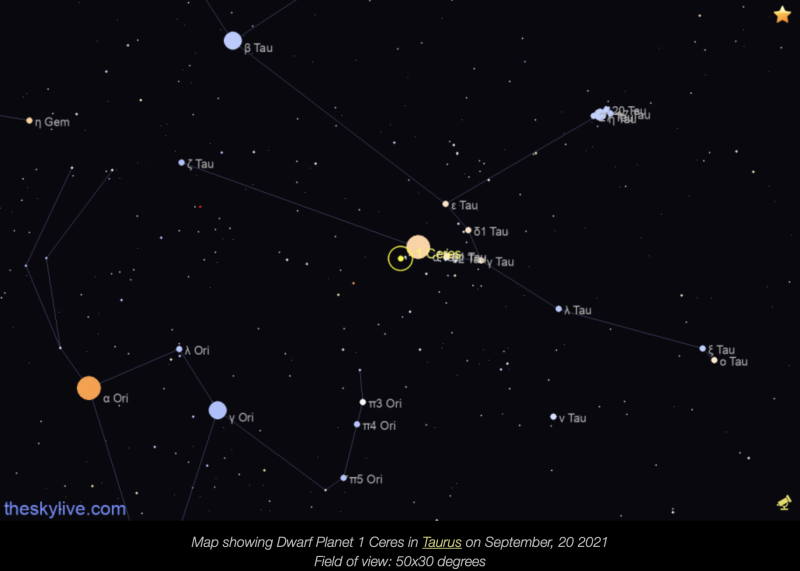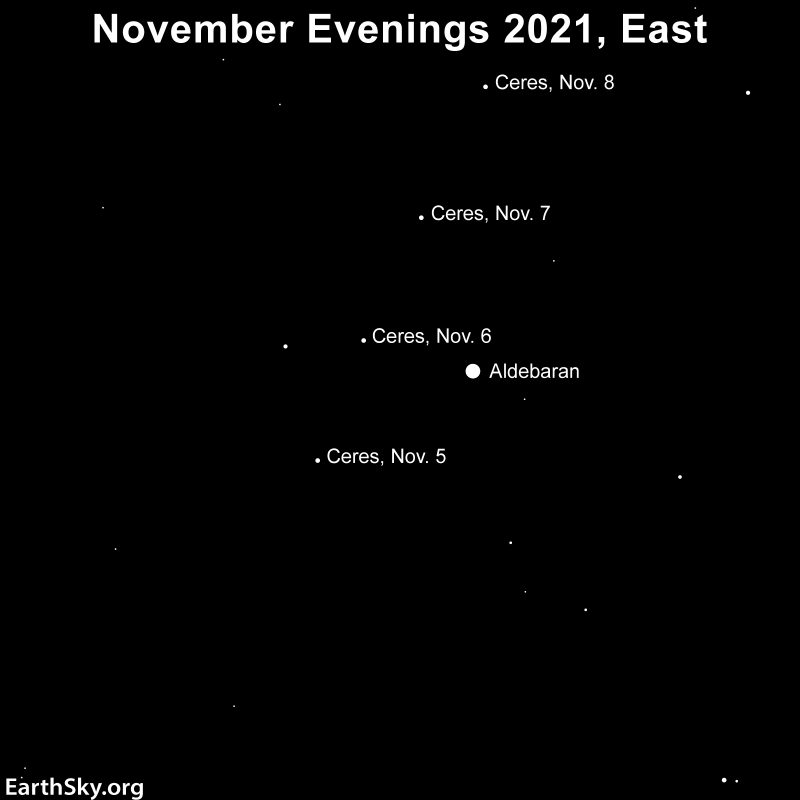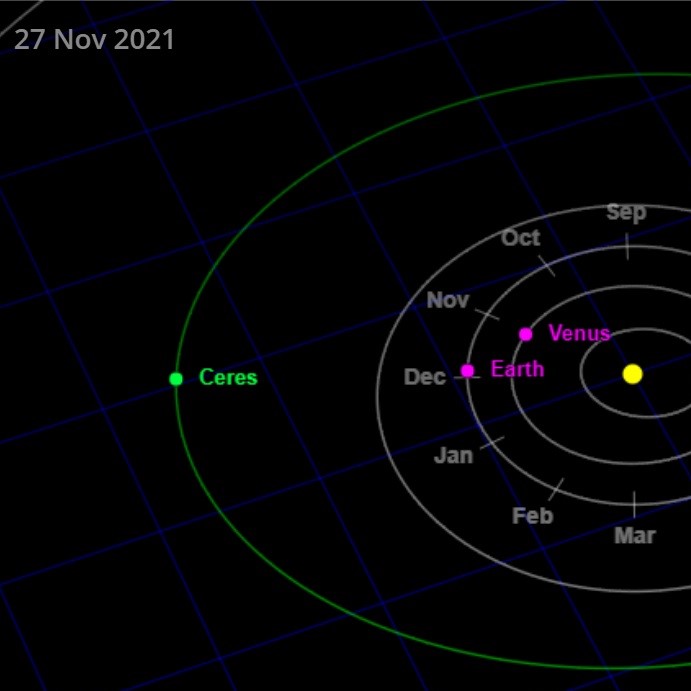
Ceres was the first asteroid discovered, in 1801. The International Astronomical Union reclassified it and Pluto as dwarf planets in 2006. Ceres is the largest object in the asteroid belt between Mars and Jupiter. It’s the only world in the asteroid belt with enough mass – and therefore enough self-gravity – to pull itself into the shape of a ball. So Ceres is the only dwarf planet in the asteroid belt, or even inside the orbit of Neptune, for that matter. In 2021, Ceres will be at opposition – opposite the sun in our sky – on November 27. At that time, it’ll rise at sunset and set at sunrise. Early November provides a unique opportunity to spot Ceres as it passes the bright star Aldebaran.
The Dawn spacecraft at Ceres
Ceres is about 600 miles (1,000 km) across, or about 1/4 the size of our moon. With its size wedged somewhere between an asteroid and a planet, Ceres was a target for study by the Dawn spacecraft.
Dawn arrived at Ceres in 2015. The spacecraft caused a stir while approaching Ceres, when it began to capture images of bright spots on the dwarf planet’s surface. People joked that the spots looked like alien headlights. But they turned out to be salt deposits from salty water inside the planet. Dawn also found a 2.5-mile (4,000-meter) high mountain called Ahuna Mons.
How to view Ceres at opposition
If you have a telescope or good binoculars, now is the time to start watching Ceres. Note that the name asteroid means starlike. From Earth, Ceres looks like a star. But because it’s so close to us, it can be seen to move in front of the stars from night to night.

Dust off your binoculars or telescope and head to a dark-sky site to see Ceres. The brightness of astronomical objects is measured in something called magnitude, with lower numbers indicating brighter objects. From a location free of light pollution, you can see objects down to about magnitude 6. In early November, the moon is near new phase, allowing for the darkest skies and better opportunities to pick out this dim world. Ceres is about magnitude 7.6 in early November, and will be at its brightest (magnitude 7) in late November. So you can see you’ll need optical aid to bag this unique object.
Ceres will move in front of the constellation Taurus the Bull all through November. Specifically, you’ll want to look for it within the V-shape Hyades star cluster in Taurus. Look now to find it near the bright reddish-orange star Aldebaran, the brightest star in Taurus.
Ceres near Aldebaran
The easiest time to find Ceres in 2021 might be the first few days of November. Ceres will pass less than a moon’s width from Aldebaran in Taurus around these evenings. If you focus binoculars or a telescope on Aldebaran, the point of light close to the star will be Ceres. Sketch the field of view around Aldebaran, then come back on consecutive nights to see which “star” moved.
The date on which Ceres will be closest to Aldebaran varies depending on what planetarium source you use. Check out the finder maps below, and then judge for yourself on what date you saw the pair closest together.


Why Ceres is so dim
Ceres orbits our sun at a greater distance than Earth. Its average distance from the sun is about 2.77 times that of the Earth. And so Ceres’ brightness doesn’t vary much throughout the year. Being small, far away and dim, it requires at least binoculars to spot and even then it only appears as a point of light like a distant star.
Ceres does us no favors in terms of its reflectivity. Objects have a measurement called albedo, which is a number between 0 and 1 for how black or white they are. Very reflective fresh snow or ice can have an albedo of 0.8 or 0.9. Our neighboring planet Venus is often said to appear bright to us because its thick cloud cover reflects so much sunlight. Venus has an albedo of 0.65. On the other hand, low-albedo objects absorb most sunlight and are quite dark. Charcoal and fresh asphalt both score 0.04 for their albedo. Ceres’ albedo is 0.07. It’s practically hiding in the dark against the blackness of space.
Ceres may be the brightest dwarf planet as seen from Earth, but only because it lies within the asteroid belt, the zone of solar system debris between Mars and Jupiter. Pluto’s albedo is 0.30 and Eris’ is 0.86, one of the highest albedos in the solar system. Ceres is only about three times farther from the sun than Earth. Compare that to Pluto, which is 40 times farther from the sun than Earth. And Eris is a whopping 68 times farther from the sun.

Bottom line: With Ceres at opposition November 27, the dwarf planet is closest to Earth and therefore brightest, making it a great time to observe. Ceres will be near Aldebaran around the first few days of November.
The post Ceres at opposition in November first appeared on EarthSky.
from EarthSky https://ift.tt/3nNzxZ2

Ceres was the first asteroid discovered, in 1801. The International Astronomical Union reclassified it and Pluto as dwarf planets in 2006. Ceres is the largest object in the asteroid belt between Mars and Jupiter. It’s the only world in the asteroid belt with enough mass – and therefore enough self-gravity – to pull itself into the shape of a ball. So Ceres is the only dwarf planet in the asteroid belt, or even inside the orbit of Neptune, for that matter. In 2021, Ceres will be at opposition – opposite the sun in our sky – on November 27. At that time, it’ll rise at sunset and set at sunrise. Early November provides a unique opportunity to spot Ceres as it passes the bright star Aldebaran.
The Dawn spacecraft at Ceres
Ceres is about 600 miles (1,000 km) across, or about 1/4 the size of our moon. With its size wedged somewhere between an asteroid and a planet, Ceres was a target for study by the Dawn spacecraft.
Dawn arrived at Ceres in 2015. The spacecraft caused a stir while approaching Ceres, when it began to capture images of bright spots on the dwarf planet’s surface. People joked that the spots looked like alien headlights. But they turned out to be salt deposits from salty water inside the planet. Dawn also found a 2.5-mile (4,000-meter) high mountain called Ahuna Mons.
How to view Ceres at opposition
If you have a telescope or good binoculars, now is the time to start watching Ceres. Note that the name asteroid means starlike. From Earth, Ceres looks like a star. But because it’s so close to us, it can be seen to move in front of the stars from night to night.

Dust off your binoculars or telescope and head to a dark-sky site to see Ceres. The brightness of astronomical objects is measured in something called magnitude, with lower numbers indicating brighter objects. From a location free of light pollution, you can see objects down to about magnitude 6. In early November, the moon is near new phase, allowing for the darkest skies and better opportunities to pick out this dim world. Ceres is about magnitude 7.6 in early November, and will be at its brightest (magnitude 7) in late November. So you can see you’ll need optical aid to bag this unique object.
Ceres will move in front of the constellation Taurus the Bull all through November. Specifically, you’ll want to look for it within the V-shape Hyades star cluster in Taurus. Look now to find it near the bright reddish-orange star Aldebaran, the brightest star in Taurus.
Ceres near Aldebaran
The easiest time to find Ceres in 2021 might be the first few days of November. Ceres will pass less than a moon’s width from Aldebaran in Taurus around these evenings. If you focus binoculars or a telescope on Aldebaran, the point of light close to the star will be Ceres. Sketch the field of view around Aldebaran, then come back on consecutive nights to see which “star” moved.
The date on which Ceres will be closest to Aldebaran varies depending on what planetarium source you use. Check out the finder maps below, and then judge for yourself on what date you saw the pair closest together.


Why Ceres is so dim
Ceres orbits our sun at a greater distance than Earth. Its average distance from the sun is about 2.77 times that of the Earth. And so Ceres’ brightness doesn’t vary much throughout the year. Being small, far away and dim, it requires at least binoculars to spot and even then it only appears as a point of light like a distant star.
Ceres does us no favors in terms of its reflectivity. Objects have a measurement called albedo, which is a number between 0 and 1 for how black or white they are. Very reflective fresh snow or ice can have an albedo of 0.8 or 0.9. Our neighboring planet Venus is often said to appear bright to us because its thick cloud cover reflects so much sunlight. Venus has an albedo of 0.65. On the other hand, low-albedo objects absorb most sunlight and are quite dark. Charcoal and fresh asphalt both score 0.04 for their albedo. Ceres’ albedo is 0.07. It’s practically hiding in the dark against the blackness of space.
Ceres may be the brightest dwarf planet as seen from Earth, but only because it lies within the asteroid belt, the zone of solar system debris between Mars and Jupiter. Pluto’s albedo is 0.30 and Eris’ is 0.86, one of the highest albedos in the solar system. Ceres is only about three times farther from the sun than Earth. Compare that to Pluto, which is 40 times farther from the sun than Earth. And Eris is a whopping 68 times farther from the sun.

Bottom line: With Ceres at opposition November 27, the dwarf planet is closest to Earth and therefore brightest, making it a great time to observe. Ceres will be near Aldebaran around the first few days of November.
The post Ceres at opposition in November first appeared on EarthSky.
from EarthSky https://ift.tt/3nNzxZ2

Aucun commentaire:
Enregistrer un commentaire